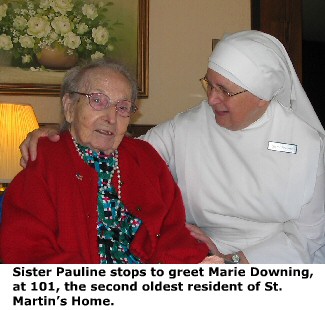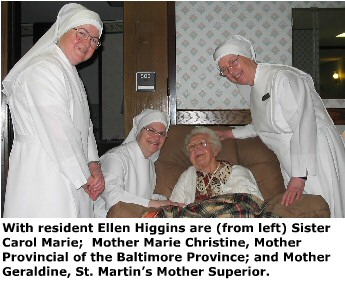|
Back to the August 2006 Newsletter Index OLD AND POOR? LITTLE SISTERS’LL LOVE YOUIt’s 6:30 a.m. on a Tuesday morning and Sister Pauline has gone grocery shopping. Well, not “shopping,” exactly. Sister has driven down to the Maryland Produce Market in Jessup to beg for food. She is back by 10 a.m. “All the vendors gave us food in cases. We came home with a truckload,” she reports with a big grin. “Home” is St. Martin’s Home in Catonsville, where the Little Sisters of the Poor care for the elderly poor. In addition to the wholesale center in Jessup, the sisters beg for their elderly charges at the Safeway and Giant distribution centers, and at produce markets and office buildings. On weekends they stand in church vestibules, smiling and meek, silently holding out wicker donation baskets as parishioners leave Mass.
They make it a point not to accept endowments or government grants. Both would likely come with strings attached, of course - restrictions on what they could do and how they could do it. But more than that, the sisters are determined to rely firmly on Divine Providence and their patron, St. Joseph, just like their foundress, Blessed Jeanne Jugan. Back in 1839, the humble French fisherman’s daughter began her mission of caring for the aged poor by carrying a blind and infirm widow up the steps to her second floor apartment and giving the poor old woman her own bed. The number of sick, aged women in Jeanne’s care grew. Many of them had been street beggars. Jeanne buried her pride and, basket on her arm, went out to beg for them in their place. Jeanne Jugan’s apostolate to the poor spread throughout France and eventually to other countries. The Little Sisters arrived in Baltimore in 1869 and began caring for elderly widows in a house on Calvert Street. When they outgrew the house, they moved to Valley Street near Johns Hopkins Hospital, where they remained for almost 100 years. They have been at their home on Maiden Choice Lane since 1969. There, 18 sisters, with the help of a lay staff and 100 volunteers, care for 92 residents. Applicants for St. Martin’s must be at least 60 years old, but the average age is 89. “They can’t have a lot of money; we’re for the poor,” says Sister Pauline. The average ratio of caregivers to residents in old age homes is 1-17; at St. Martin’s it’s 1-5. “We welcome the elderly as we would Jesus Christ Himself,” reads the Little Sisters’ mission statement, which helps explain why the home is always full and there is always a waiting list. “When they come into the home, they might be very quiet,” says Sister Pauline. “But when they see the social life and the love of the sisters, they’ll start blooming – coming to the sing-alongs and the exercise classes. Within a month, I guarantee you, they’ll gain ten pounds!” The sisters also encourage the more able to do small household tasks, thus helping them to feel they are contributing members of their new home.
“We offer our residents a family-like environment where their dignity is maintained,” says Meg Ducey, the home’s development director. “We have lots of activities, lots of parties!” In addition to physical therapy, there is a dental office on the premises, and doctors make regular visits. There are three nursing units: Fatima, Lourdes and St. John of God; an assisted living unit, Immaculate Conception; and two independent living units: St. Joseph’s and Jeanne Jugan. Every resident has his or her own room, furnished with their own belongings. Meals are served family-style in the nursing and assisted living sections. Residents in the independent living units can cook in their own apartments or eat in their unit’s dining room. Sister Pauline, who has been a professed nun for 43 years, is well aware that the Little Sisters’ devotion to the elderly poor is at odds with mainstream culture. “People nowadays think that old age and suffering are something terrible, to be avoided,” she says. “But old age has its beauty; suffering has its grace that comes from God.” When the time comes, the majority of their residents die very tranquilly, notes Sister. “We just had a lady who died the other day. All the sisters were there, singing and praying; it was so peaceful. “When they’re dying, the sisters are there 24 hours a day, caring, loving them – that’s our vocation.” St. Martin’s is the provincial house for the Little Sisters’ Baltimore Province, which stretches down to Mobile, Ala. “Everyone shares among the ten homes in the province,” says Sister; “we network.” The networking system went into full gear when Hurricane Katrina hit last summer. The Little Sisters evacuated the 65 residents at their New Orleans home, eventually flying them up to St. Martin’s for disbursement to their various homes throughout the province. “One woman told us she had nothing but the clothes she was wearing and a comb,” Sister recalls. “We said, ‘Don’t worry, honey, we’ll take care of you!” It’s a promise well-kept; Hurricane Katrina is no match for the Little Sisters of the Poor. |

 Begging is not something the Little Sisters of the Poor do
by default. It’s an integral part of who they are.
Begging is not something the Little Sisters of the Poor do
by default. It’s an integral part of who they are. A visitor to St. Martin’s will find an atmosphere that may
not display the elegance and style of some of the more affluent
retirement homes, but offers instead a pleasant and comfortable
homeyness.
A visitor to St. Martin’s will find an atmosphere that may
not display the elegance and style of some of the more affluent
retirement homes, but offers instead a pleasant and comfortable
homeyness.